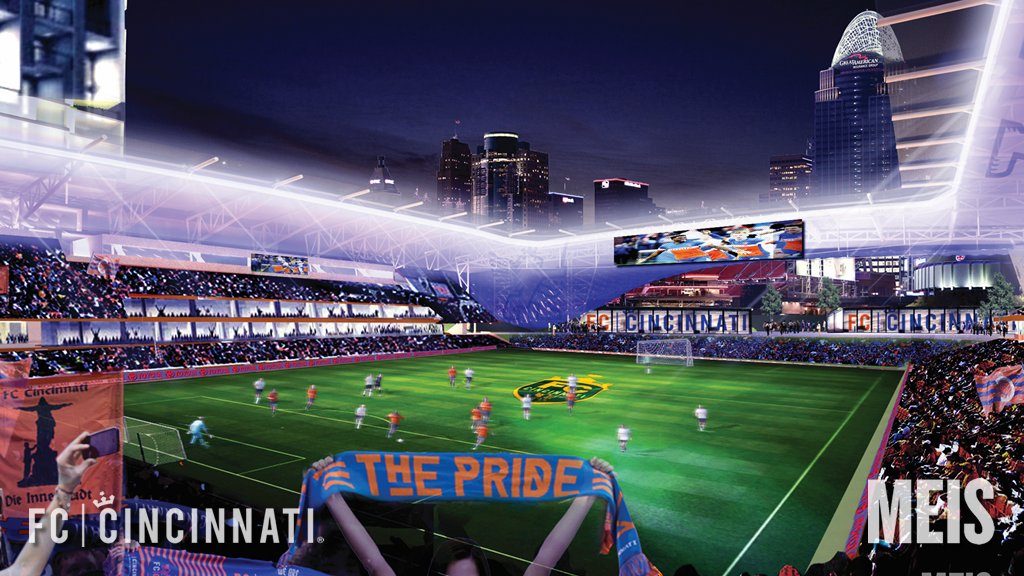I’m sure you have read about 50 stories over the past month on the struggles of landing a soccer-specific stadium in Ohio for FC Cincinnati. The leadership of Hamilton County and the City of Cincinnati have begun to make progress towards a deal, but a rumored budget gap of $20-25 million may be a sticking point to keep the team on the north side of the river. CST has been flooded with emails and comments on social media declaring that the team just “move on to Newport”. We wanted to share an editorial letter written to us by a fan supporting the club moving to the Commonwealth. We hope you take the time to read this piece from FCC supporter Ian Taylor.
The Hamilton County Commissioners addressed the media last week and put FC Cincinnati supporters into a frenzy on the Club’s potential Major League Soccer stadium deal in the state of Ohio. There is no denying that a large, vocal group of fans want the Club’s MLS-hopeful soccer-specific stadium in the city of Cincinnati. However, with the seeming lack of serious interest from Hamilton County elected officials to finalize a deal and the timeline in which the Club has to get a deal done, maybe it is time to look at the Newport site with open minds. In my mind, I think it is the best site and arguably has been the best location for the Club all along.
Hear me out…
The Oakley neighborhood is roughly eight miles northeast of downtown Cincinnati. It is the location of recent large suburban developments that are home to national or regional big-box retailers and residential apartments. The Center of Cincinnati development is roughly 60 acres and is home to retail tenants like Sam’s Club, Meijer, Target, IHOP, and PetSmart, among others. Adjacent sits the newer Oakley Station suburban development. This was phase three that expanded the Center of Cincinnati by adding 74 more acres of suburban development. Oakley Station’s key tenants are Kroger Marketplace, Cinemark Theaters and 450 apartments across seven buildings. Also scattered throughout the development site are office space locations, along with new retail tenants such as the Olive Garden, Bar Louie, MOD Pizza, Chik-fil-a, and Raising Cane’s.
Altogether this results in a suburban site that is surrounded by thousands of surface parking spaces. Large interstates and heavily trafficked roads dominate the north, west, and east boundaries of the site. Only to the south do you find any semblance of an urban neighborhood. Roughly half a mile south is the brand new MadTree Brewery, while another half mile down Madison Road sits entertainment spots like Animations, Oak Tavern, Habits, and Oakley Pub & Grill. All of these places will be popular choices for match goers, but none of them have had the opportunity to host 20,000+ fans on a matchday. One block off of Madison Road you will find single-family homes popular among young professionals and middle-aged families.
The proposed Newport, Kentucky site sits at the mouth of the Licking River along the banks of the Ohio River. The seller has long earmarked it for a 35-acre, $1Billion mixed-use development, called Ovation, which has never come to fruition. The site sits just over the river levee with unobstructed views towards downtown Cincinnati. It is seemingly the last available location for major stadium development along the riverfront. Newport, obviously, is home to the formerly popular Newport of the Levee development that dominates the southern skyline of the riverfront. Once a bustling mixed-use development to the east of the proposed stadium location, the Levee has fallen on hard times and now struggles to keep regular tenants. But, you could also assume that with the addition of a new stadium next door, there would be an injection of new life that could prevent it from becoming a vacant shell casting shadows over the skyline.
To the west of the Ovation site, across the Licking River, is the City of Covington. Seven Historic Preservation Overlay zones cover Covington maintaining the architecture and urban fabric of the streets much like Over-the-Rhine. There is an entertainment district on Madison Ave. near Pike St. and further west, roughly 1.5 miles from the proposed site, is Mainstrasse Village. To the north, over the Purple People Bridge or the Suspension Bridge, is downtown Cincinnati. Everyone should be familiar with the Banks mixed-use development that regularly hosts fans for both Reds and Bengals games. The matchday experience on the riverfront can offer fans more options that have proven they can handle crowds.
FC Cincinnati President and GM, Jeff Berding, has been saying since day one that he and majority owner Carl Lindner III started this franchise because the Greater Cincinnati area is a “city on the rise.” We have heard him use the phrases “major league” and “world class” countless times. So how do these two sites compare on the merits of those phrases? A bid to Major League Soccer means being recognized on a much more global scale through not only hosting league opponents, but also the potential for hosting MLS All-Star games, US national team matches, and international friendlies such as the International Champions Cup.
Imagine the visuals from the ground and airships being broadcasted on television around the world. These images are an immediate advertisement for our metropolitan area and should be as iconic as our skyline, Music Hall and Union Terminal. We want to showcase the best face of our city and create a look that is desired by fans to come visit. I personally think a stadium with the Bailey on the levee end of the pitch with the skyline of downtown Cincinnati as a backdrop is a more compelling visual than a background of surface parking lots and big-box retailers.
Berding has also mentioned that the stadium will generate additional private development, which is to be expected. A stadium needs various amenities around it for it to be a successful draw. However, I don’t think any new mixed-use development around Oakley Station as a result of a new stadium will change the suburban context in which the site is located. The interstates are not moving and the above-mentioned retailers aren’t going away, either. Additionally, we need to think about further development opportunities and what their potential is, both in the immediate neighborhood and across the whole metropolitan area. Will more mixed-use development in Oakley change the perception of our city and make it more desirable from a national perspective?
Downtown Cincinnati, Covington, and Newport are going through revitalizations that are matched by few, if any, urban neighborhoods in the country. These neighborhoods are what are turning heads and changing national perceptions with their restored architecture and history. These “urban core” neighborhoods are what our corporate community have invested hundreds of millions of dollars into over the last decade to keep and attract new talent. These neighborhoods have created an identity for our city.
Think back to the MLB All-Star game and what came with it from an infrastructure standpoint. Also think of the city’s largest global event, the Western & Southern Open tennis tournament. The city has to accommodate transportation, lodging, dining, and entertainment for thousands of fans and media alike. The same will be true for the previously mentioned global soccer events. Now imagine those same types of events being hosted in Oakley. Where does the influx of media and fans stay, eat, and go out?
I imagine the vast majority will continue to stay downtown where that infrastructure already exists to host “major league” events. There are more than enough new hotels downtown that you have to ask yourself if even more are built in Oakley, is it a waste of development opportunities? A new stadium would also need space for additional events that come with hosting the aforementioned high exposure matches, like fan zones and interactive areas. Oakley could host fan zones in the surrounding retail parking lots in a block party setup as long as they do not interfere with traffic patterns getting people into the stadium and retailers. The Newport location could host fan zones on the riverside of the levee, Newport on the Levee, the intersection of Court Ave. and Park Place in Covington, and on the Ohio side at the Banks, Sawyer Point Park, and Smale Riverfront Park.
As a region, we need to capitalize on the development assets we already have and focus our efforts to ensure their long-term success. In the case of a new soccer-specific stadium, I think this should mean capitalizing on the infrastructure already in place along the river in our urban core rather than replicating in the more residential dominated neighborhood of Oakley.
Another side of infrastructure that is often mentioned, but not talked about enough, in my opinion, is transportation and parking. On days where there are no other competing factors, traffic is already difficult in that area. FC Cincinnati midweek US Open Cup matches with a 7 o’clock kickoff will have to compete with regular rush hour traffic. Thousands of fans would flock out of downtown to sit in traffic on their way to Oakley on top of regular commuters. Conversely, if there was a stadium along the riverfront, many of those same people could stay after work and have a short commute in their cars or on foot to the stadium. Also, public transportation makes the urban core more accessible and can help grow the support base. Metro bus services converge downtown, which can then be linked with Northern Kentucky via the TANK or Southbank Shuttle. There are also Red Bike stations throughout downtown Cincinnati, Covington, and Newport that could help serve fans. If there is a stadium in Newport, there is then a strong incentive to extend the streetcar across the river, making it a truly useful mode of transportation. Lastly, there is the fun possibility of water taxis that could shuttle fans from one side of the river to the other.
Parking is the other side of the traffic coin. We have been forced to focus more on it in the past couple days after the Hamilton County Commissioners offered to build a 1,000 space parking garage in Oakley to supplement a stadium. If that is the only parking structure in the plan, then there will be a massive spillover of cars into surrounding parking lots and neighborhood streets. With all of the residential parking needs that exist already, I question the ability of the neighborhood streets to support a sold-out stadium. It is also unlikely that all of the retail businesses in the Center of Cincinnati and Oakley Station would agree to allow match goers to park wherever they wanted.
I think it can go without being said, but the riverfront already has large parking infrastructure designed for tens of thousands of sports fans. The infrastructure can accommodate multiple sporting events at a time apart from the existing adjacent commercial and residential needs.
Lastly, it is important to look at the financial side of the proposed sites. We all know that the Club’s ownership group have agreed to finance 100% of the stadium in Oakley. In return, they are requesting that local governments together fund $75M of infrastructure needed for stadium development through various financial vehicles. The plan set forth by Mayor Cranley deserves some critical eyes before approving decades-long sources. Hamilton County is in desperate need of funds for other major improvements like the $300M+ Western Hills Viaduct project and an unknown amount of repairs and upgrades to the Metropolitan Sewer District. The Southern Ohio Regional Transit Authority (SORTA) is also in desperate need of additional funding in order to prevent major service reductions throughout Hamilton County. Similarly, within the next decade, there will be more calls for upgrades to US Bank Arena and the Cincinnati Convention Center. All of this doesn’t mention the glaring need for public funds for the Brent Spence Bridge project that affects both sides of the river. With those on the horizon, it might be in our best interest to use public funds to save our existing assets rather than create a new publicly-owned stadium.
While I find it interesting that there has been little mention of the Newport site’s financing plan, we do know that there is a TIF district in place as well as a financing plan. With Campbell County apparently wanting to lure FC Cincinnati to Newport with incentives, you could think that there is a possibility of a package that allows FCC to immediately increase their stadium capacity to the 25,000-seat mark. This would represent phase two of the three-phase plan to achieve a 30,000-seat capacity. Moving to Newport would also allow Hamilton County to save funds for the previously mentioned projects, as well as look ahead to commitments to Paul Brown Stadium and Great American Ballpark in the next five years.
However, that is not to say that Hamilton County’s loss of a stadium would mean no economic impact from an MLS franchise. I think Hamilton County would still benefit greatly from a Newport stadium without the direct investment in the stadium or its infrastructure. As I have mentioned before, both the City of Cincinnati and Hamilton County will feel the economic impact of Major League Soccer through parking and hotel revenues, as well as the entertainment impact throughout downtown and the Banks from fans and media.
Apart from the pro-Ohio contingent, the biggest supporters of the Oakley proposal are seemingly coming from two major groups: the “whatever gets us in MLS” group and the “I live nearby” group. Local residents need to take some time to think when it comes to this decision, which will affect the metropolitan area and Club for the next 40 or so years.
If you are in the first group of proponents, then I should remind you that ANY stadium location would likely get us a bid. This means that you might not fully support Oakley, so open up to the thought of Newport. For those that want an Oakley stadium because it is convenient for you, think about if it is convenient for the rest of the region. Even if a large number of season ticket holders live in and around Oakley, the Club still wants to expand its fan base and gain more season ticket holders around the region. A centralized location that is accessible for the entire metropolitan area opens up the potential reach of the fan base. That is what ultimately determines the long-term success of the Club.
We, as a region, cannot afford to be shortsighted with other big issues on the horizon for the City of Cincinnati and Hamilton County. I think the Newport site is the best option and ticks all the boxes for perception to nonresidents, additional development opportunities, infrastructure, parking, and transportation. This allows Cincinnati and Hamilton County to generate a hefty percentage of the economic impact revenue without any of the investment, freeing it up for other projects in the decades to come.
Is all of that worth sacrificing for the sake of a state line that is only really perceived as a barrier from residents of one side of the river? A soccer-specific stadium in Newport means a Major League Soccer franchise for FC Cincinnati, so why leave that offer on the table? We are running out of time, so now is the time to act.
Ian Taylor
[getsocial app=”sharing_bar”]













